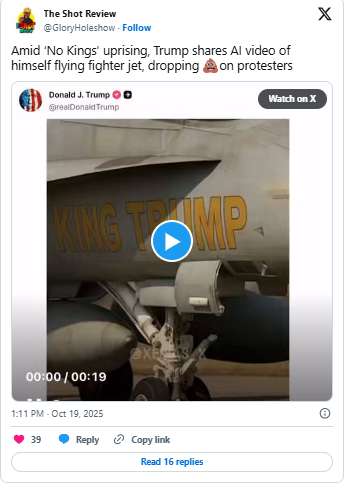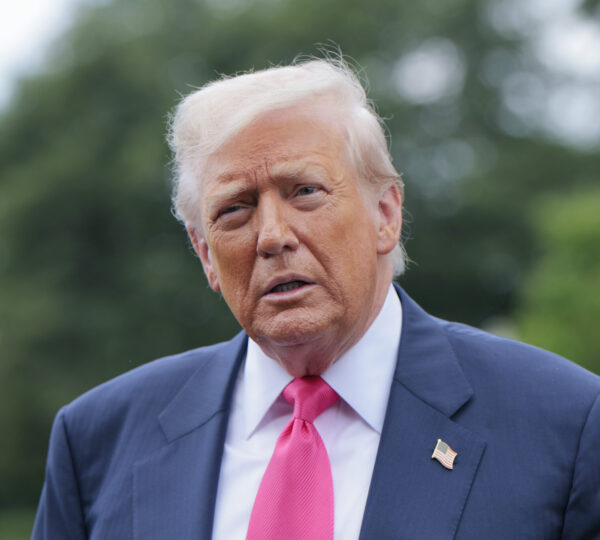
On Saturday, massive crowds of Americans gathered across the United States to participate in the nationwide “No Kings” protests, voicing their opposition to what they view as President Donald Trump’s increasingly authoritarian actions. Demonstrations took place in over 2,500 cities across all 50 states, including major metropolitan centers such as New York City, Washington D.C., Miami, and Los Angeles. Reports suggest that millions of people joined the rallies, holding signs that read “Democracy, Not Monarchy” and “The Constitution Is Not Optional,” and calling for limits on presidential power in order to preserve democratic governance.
High-profile Democrats were widely visible at the protests, marching alongside ordinary citizens and lending their voices to the movement. Senators Bernie Sanders, Cory Booker, Chuck Schumer, and Raphael Warnock, along with Representative Adam Schiff, were seen engaging with participants, emphasizing that the rallies were not just political demonstrations but a broader stand for the principles of democracy itself. “There are clearly more of us than there are of those who want an autocracy or a dictatorship,” Colleen Connell, executive director of the Illinois chapter of the American Civil Liberties Union, told CNN. “The message is clear: We, the people, own this country.
We will respect the rule of law, stand up for our rights, and protect our democracy through peaceful protest and peaceful dissent.” However, President Trump’s reaction to the nationwide protests quickly escalated tensions. Rather than addressing the demonstrators’ concerns directly, he shared a bizarre and controversial AI-generated video on social media. In the clip, Trump appeared flying a fighter jet labeled “KING TRUMP” over New York City while wearing a gold crown, set to Kenny Loggins’ iconic song “Danger Zone” from Top Gun. The video depicted him dropping what appeared to be sewage onto protestors below.

The surreal content provoked immediate backlash online, with social media users expressing shock and disbelief. Comments ranged from, “Imagine just one second that any other president ever did something like this,” to, “Every time he does anything, I truly question whether this is real life. He’s supposed to be a grown man.” Vice President JD Vance also joined in the digital display, posting a meme on Bluesky that depicted prominent Democratic leaders kneeling before Trump in a royal court. The imagery reinforced the perception that Trump was leaning into a “king” persona, further inflaming public debate over his behavior and the appropriateness of such communications from a sitting president.
According to Variety, Trump continued to lean into this narrative by posting another clip in which he placed a crown on his head while the heavy metal track “Hail to the King” by Avenged Sevenfold played in the background. Despite widespread criticism, he remained unapologetic, claiming in a Fox News interview that references to him as a king were not literal: “A king! This is not an act. You know — they’re referring to me as a king. I’m not a king.” In addition to sharing these videos, Trump dismissed the nationwide protests themselves.
In public remarks, he described the demonstrations as “a joke” and “very small, very ineffective,” insisting that those who participated did not represent the majority of Americans. Speaking to reporters aboard Air Force One the following day, he reiterated his stance, asserting, “When you look at those people, those are not representative of the people of our country.” These comments provoked further debate, as protesters and political commentators argued that the demonstrations reflected widespread concern over executive overreach and the health of U.S. democracy.

Republican leaders also criticized the “No Kings” movement. House Speaker Mike Johnson condemned the rallies as “Hate America” events and accused Democratic organizers of commercializing the protests by selling T-shirts for fundraising purposes. Johnson further linked the protests to ongoing political issues, claiming that government operations could not resume because officials feared confronting the “rabid” base of the protestors.
In response, the No Kings coalition issued a statement to Politico, highlighting the contrast between Trump’s criticisms and the actual focus of the demonstrators. “Instead of reopening the government, preserving affordable healthcare, or lowering costs for working families, he’s attacking millions of Americans who are peacefully coming together to say that America belongs to its people — not to kings,” the statement read. Supporters of the movement emphasized that the protests were entirely nonviolent, meant to underscore the importance of constitutional checks on executive power, and to assert the principle that no individual should wield unchecked authority in a democratic society.
As the weekend concluded, the “No Kings” protests had achieved significant visibility, sparking debate about the role of protest in American democracy, the limits of presidential authority, and the impact of digital media on political discourse. While Trump and his allies continued to frame the demonstrations as extreme and unrepresentative, the sheer scale of the events suggested a broad, nationwide concern about the state of governance and civic accountability. The events also highlighted the growing tension between social media, AI-generated content, and traditional political messaging, raising new questions about how leaders communicate and how citizens respond in the digital age.


